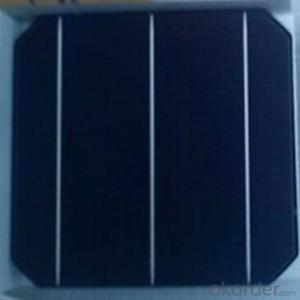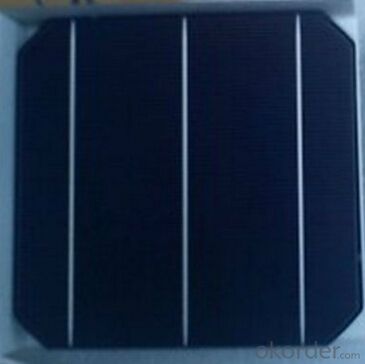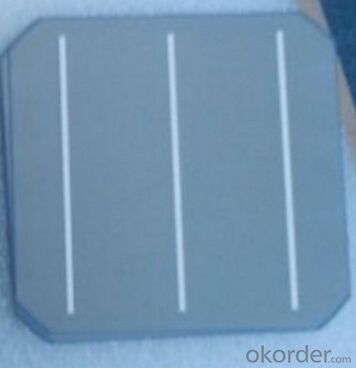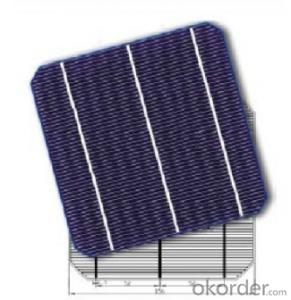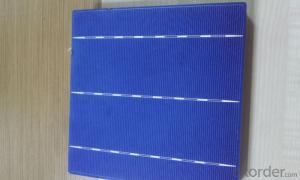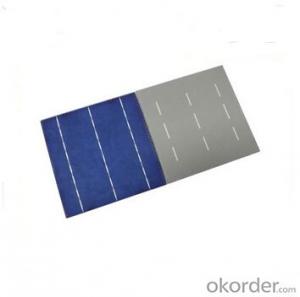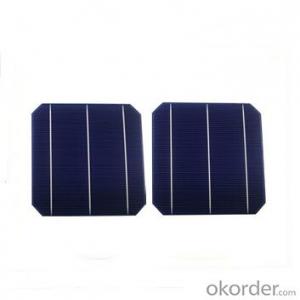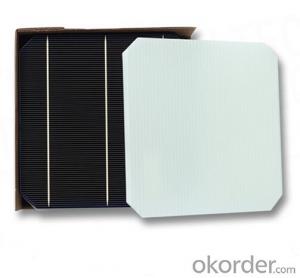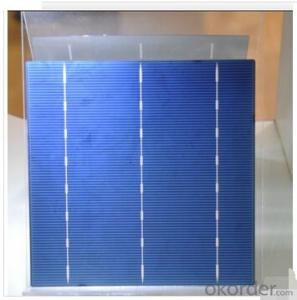Plant Based Monocrystalline Solar Cells Series-- 18.2%
- Loading Port:
- Shanghai
- Payment Terms:
- TT OR LC
- Min Order Qty:
- 1000 pc
- Supply Capability:
- 100000 pc/month
OKorder Service Pledge
OKorder Financial Service
You Might Also Like
Solar Cells:
Solar cells is made by solar wafer, it has three categories of solar cell right now, monocrystalline polycrystalline and thin film,These cells are entirely based around the concept PNjunction, which is the critical part of solar module, it is the part that can convert the light energy into electricity, the thickness is from 180um to 200um, with even busbars to conduct electricity, textured cell can decrease diffuse reflection; they are often electrically connected and encapsulated as a module. Photovoltaic modules often have a sheet of glass on the front (sun up) side, allowing light to pass while protecting semiconductor wafers from abrasion and impact due to wind-driven debris, rain, hail, etc. Solar cells are also usually connected in series in modules, creating an additive voltage. Connecting cells in parallel will yield a higher current;With high quality and stable quality. Our Cells can greatly improve the performance of Solar Modules.
Features:
High conversion efficiencies resulting in superior power output performance.
Outstanding power output even in low light or high temperature conditions
Optimized design for ease of soldering and lamination
Long-term stability,reliability and performance
Low breakage rate
Color uniformity
Specifications:
Dimension: 156mm±0.5mm
Wafer Thickness: 200μm±20μm
Diagonal: 200mm±1.0mm(round chamfers)
Front: 1.5mm Silver bus bars; Blue/others silicon nitride antireflection coating
Back: 3.0mm Silver bus bars; Full-surface aluminum BSF
Efficiency | Efficiency | Pmax(W) | Average | Impp(A) | Vmpp(V) | Isc(A) | Voc(V) |
1840 | 18.30-18.50 | >4.371 | >4.371 | 8.285 | 0.530 | 8.695 | 0.626 |
1820 | 18.10-18.30 | 4.323-4.371 | 4.347 | 8.245 | 0.528 | 8.662 | 0.626 |
1800 | 17.90-18.10 | 4.276-4.323 | 4.299 | 8.190 | 0.526 | 8.630 | 0.625 |
1780 | 17.70-17.90 | 4.228-4.276 | 4.252 | 8.140 | 0.524 | 8.621 | 0.624 |
1760 | 17.50-17.70 | 4.180-4.228 | 4.204 | 8.095 | 0.522 | 8.598 | 0.623 |
1740 | 17.30-17.50 | 4.132-4.180 | 4.156 | 8.045 | 0.520 | 8.568 | 0.622 |
1720 | 17.10-17.30 | 4.085-4.132 | 4.108 | 7.905 | 0.518 | 8.528 | 0.620 |
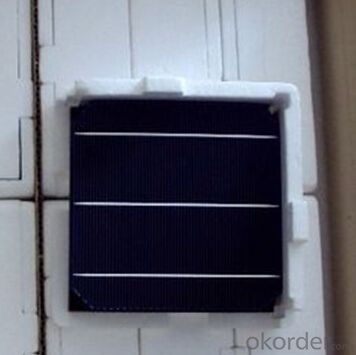
Solar Cells Advantage:
• High efficiency and stable performance in photovoltaic conversion.
• Advanced diffusion technique ensuring the homogeneity of energy conversion efficiency of the cell.
• Advanced PECVD film forming, providing a dark blue silicon nitride anti-reflection film of homogenous color and attractive appearance.
• High quality metal paste for back surface and electrode, ensuring good conductivity, high pulling strength and ease of soldering.
FAQ
We have organized several common questions for our clients,may help you sincerely:
①What price for each watt?
It depends on the efficiency of the solar cell, quantity, delivery date and payment terms.
②How long can we receive the product after purchase?
In the purchase of product within three working days, We will arrange the factory delivery as soon as possible. The pecific time of receiving is related to the state and position of customers.Commonly 7 to 10 working days can be served.
③Can you provide the peripheral products of the solar panels, such as the battery, controller, and inverter? If so, can you tell me how do they match each other?
Yes, we can, we have two companies for solar region, one is CNBM International, the other is CNBM engineering Co.
We can provide you not only the solar module but also the off grid solar system, we can also provide you service with on grid plant.
④What is your warranty of solar cell?
Our product can promise lower than 0.3% open box crack, we support claim after opening the box if it has crackm color difference or sth, the buyer should give pictures immediately, we can not accept the claim after the solar cell has assembled to solar panel.
• Timeliness of delivery
• ⑤How do you pack your products?
We have rich experience on how to pack the solar cell to make sure the safety on shipment, we could use wooden box or pallet as buyer's preference.
- Q: Does the solar cell generate electricity in the absence of the sun, only in the case of strong lights or lasers? If you can achieve how much, and the same day?
- One of the directions for the development of modern solar cells is to maximize the frequency range of the light waves that can be energized (to the low frequency direction) to increase the power generation efficiency of solar cells.
- Q: What is the maintenance required for solar cells?
- The maintenance required for solar cells primarily involves periodic cleaning to ensure maximum sunlight absorption, checking for any damage or debris, and monitoring the performance of the system to address any issues promptly. Additionally, regular inspections and maintenance of other components such as inverters, wiring, and batteries may be required to ensure optimal functioning and longevity of the solar cell system.
- Q: Can solar cells be used for powering remote communication towers?
- Yes, solar cells can be used for powering remote communication towers. Solar cells convert sunlight into electricity, which can be used to power various devices including communication towers. This is especially useful for remote areas where access to the power grid is limited or non-existent. Solar-powered communication towers offer a sustainable and cost-effective solution for maintaining connectivity in these remote locations.
- Q: Can solar cells be used in vehicles?
- Yes, solar cells can be used in vehicles. They are commonly used in electric vehicles (EVs) to charge the battery and provide power to various systems, increasing their range and efficiency. Solar panels can be installed on the roof or hood of a vehicle to capture sunlight and convert it into electricity, helping to reduce reliance on grid charging and decrease carbon emissions.
- Q: Can solar cells be used for powering remote surveillance cameras?
- Yes, solar cells can be used to power remote surveillance cameras. Solar cells convert sunlight into electricity, making them a reliable and sustainable energy source for remote locations where power supply may be limited or unavailable. By harnessing solar energy, surveillance cameras can operate continuously without the need for frequent battery replacements or connection to electrical grids.
- Q: What is the maximum efficiency that a solar cell can achieve?
- The maximum efficiency that a solar cell can achieve is known as the Shockley-Queisser limit, which is approximately 33.7%. However, in practical applications, commercial solar cells typically have efficiencies ranging from 15% to 22%.
- Q: Can solar cells be used for powering disaster relief operations?
- Yes, solar cells can certainly be used for powering disaster relief operations. Solar cells, also known as photovoltaic cells, convert sunlight into electricity, making them a reliable and sustainable source of power. In disaster-stricken areas where the conventional power grid may be disrupted or unavailable, solar cells can provide a clean and renewable energy solution. They can be used to charge batteries, power communication devices, run medical equipment, and provide lighting and electricity for essential services such as shelters, water purification systems, and refrigeration for medical supplies. Furthermore, solar cells are portable and can be easily deployed to remote or inaccessible areas, making them an ideal choice for disaster relief efforts.
- Q: Can solar cells be used for powering agricultural irrigation systems?
- Yes, solar cells can be used for powering agricultural irrigation systems. Solar energy can be harnessed by installing solar panels that convert sunlight into electricity, which can then be used to power pumps and other equipment necessary for irrigation. This renewable energy source offers a sustainable and cost-effective solution for powering agricultural practices, especially in areas with limited access to electricity.
- Q: How do solar cells handle snow or ice accumulation?
- Solar cells are designed to be durable and able to withstand snow or ice accumulation. However, when covered by snow or ice, their energy production is significantly reduced. Some solar panels are designed with a tilted angle and smooth surface, allowing snow to slide off easily. Additionally, the dark color of solar cells helps them absorb sunlight and melt the snow or ice faster. In extreme cases, manual removal of snow or ice may be necessary to restore optimal energy generation.
- Q: How is the solar cells factories working in China? Do they follow certain quality standards?
- Of course, the follow the quality assurance standard, and in fact, they are as good as the solar cell factories in US.
Send your message to us
Plant Based Monocrystalline Solar Cells Series-- 18.2%
- Loading Port:
- Shanghai
- Payment Terms:
- TT OR LC
- Min Order Qty:
- 1000 pc
- Supply Capability:
- 100000 pc/month
OKorder Service Pledge
OKorder Financial Service
Similar products
Hot products
Hot Searches
Related keywords
